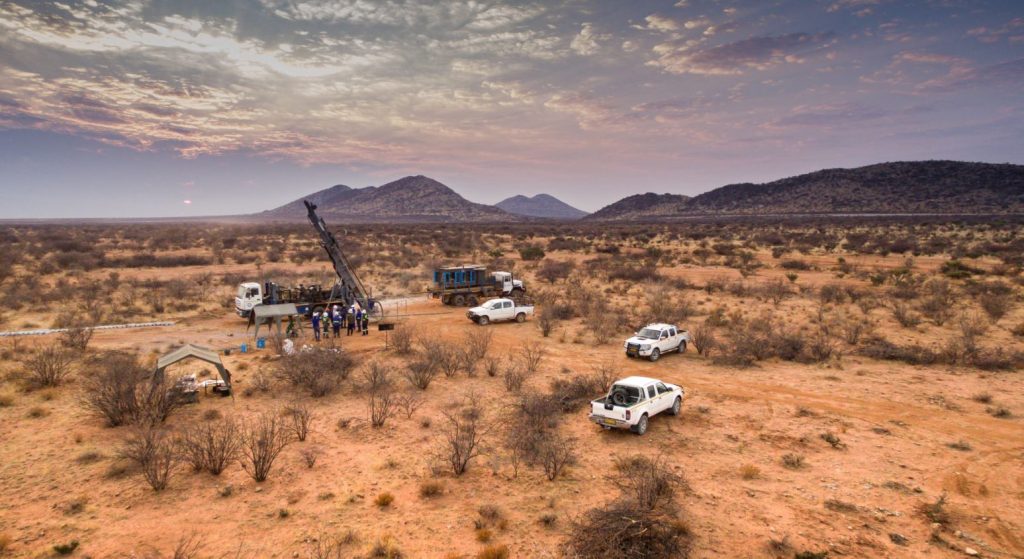Osino Resources partner drills 0.95% Li2O over 11 metres at Omaruru, Namibia

Osino Resources Corp. [OSI-TSXV; OSIIF-OTCQX; RSR1-FSE] provided an update on its majority-owned Omaruru lithium project in central Namibia following the completion of a phase 1 reverse circulation (RC) drill program by Prospect Resources Ltd. [PRSTF-OTC]. Osino entered into an earn-in and shareholder agreement with Prospect in Q4 2022 whereby Prospect can earn up to 51% and potentially up to 85% interest in the project.
Omaruru is located 20km southeast of Osino’s Twin Hills Gold Project for which a DFS is anticipated to be delivered in Q2 2023. Located east of Karibib and spanning 175 km2, Omaruru is situated near several historical and current lithium mining operations, including Lepidico’s Karibib Lithium Project located about 10 km to the southwest. Omaruru is accessible by road from the sealed B2 National Highway which links the capital Windhoek, 130 km the southeast, to the port at Walvis Bay, about 240 km farther southwest.
Heye Daun, Osino’s President and CEO, commented: “We are excited to receive excellent results generated by Prospect Resources’ team at the Omaruru Lithium Project. The Phase 1 drilling results confirm and expand the success of the early exploration and drilling programs completed by Osino between 2019-2021 and set the stage for a significant, maiden JORC-compliant resource to be delineated at Omaruru later this year. Prospect is a world-class group with a track record for exploring and developing African lithium projects, evidenced by the team’s previous success selling the Arcadia lithium project in Zimbabwe for approximately US$378M cash in 2022. Our Earn-In agreement provides Osino shareholders with continued exposure to the growing scope and excellent upside potential of the Omaruru Lithium Project.”
Omaruru contains more than 65 known and mostly zoned pegmatites which belong to the Lithium-Caesium-Tantalum (LCT) family of rare-element pegmatites. These pegmatites occur within an area known as the Karibib Pegmatite Belt, one of five major pegmatite districts in the Damara Belt.
Osino undertook an initial evaluation of the lithium potential of the Project from 2019-2021. This work included mapping, rock grab sampling and a 16 hole (1,942m) RC drill program in 2020. The drilling highlighted remaining potential at the Karlsbrunn pegmatite in particular, with a number of intersections of 5m or more at grades in the range of 1-1.2 per cent of Li2O. Other drilling and surface sampling indicated lithium mineralization associated with most of the other pegmatites on the Project.
Karlsbrunn Deposit Phase 1 Drilling Program
Significant intersections returned from Prospect’s Phase 1 Drilling Program at the Karlsbrunn deposit include 8 metres of 0.99% Li2O from 6 metres; 11 metres of 0.95% Li2O from 51 metres; 10 metres of 0.88% Li2O from 35 metres; 10 metres of 0.82% Li2O from 15 metres; and 11 metres of 0.80% Li2O from 35 metres.
These results show robust lithium grades and pegmatite widths across the deposit and are broadly in line with the initial drilling at Karlsbrunn completed by Osino in 2020.
Prospect completed its maiden drilling at the Brockmans deposit, which is located just over 4 km northeast of the Karlsbrunn deposit. Assay results are highly encouraging with two adjacent holes completed in the southern zone evidencing a new discovery of continuous lithium mineralization.
Significant intersections returned from Prospect’s Phase 1 Drilling Program at Brockmans include 6 metres of 1.30% Li2O from 13 metres within 14 metres of 0.79% Li2O from 13 metres; and 7 metres of 0.90% Li2O from 17 metres and 8 metres of 0.60% Li2O from 28 metres.
The results from this new drilling at Brockmans indicate a significant thickening of the pegmatite in the south, which is considered a key aspect for the zoning of lithium mineralization in the Karibib District (e.g. Karlsbrunn). Importantly, the limited drilling undertaken at Brockmans indicates significant prospectivity and scope for identifying larger tonnages of higher-grade lithium mineralization within the Omaruru Project
Prospect recently collected three, 50-kg bulk samples of identified lithium mineralization from the Karlsbrunn, Brockmans and Hillside deposits. These samples are set to undergo early stage metallurgical test work and evaluation in South Africa.
Prospect completed detailed soil geochemical sampling at Omaruru over eight separate grids in January. Most assays for this work remain outstanding and will be reported separately once all data is received and interpreted.
Prospect expects to complete its Phase 1 earn-in to Omaruru during Q2 2023. Upcoming programs during this period are expected to encompass infill and extensional RC drilling at the Brockmans deposit, limited diamond drilling for metallurgical test work purposes at Karlsbrunn, and potentially first-pass, short-hole, RC drilling of regional exploration targets identified from any cohesive geochemical and soil anomalies associated with LCT mineralization characteristics across the region (i.e. elevated lithium-caesium-rubidium-beryllium values).
Under the agreement, Prospect may earn-in to up to 40% interest in the project with a US$1M investment (Phase 1) and a further 11% interest through a US$560,000 investment (Phase 2), totalling a 51% ownership in the Project.
Phase 1 consists of a US$560,000 cash payment to acquire 20% and a commitment to spend a further US$440,000 on the project with a year to earn an additional 20%. Upon the completion of Phase 1, Prospect may commit to a further US$560,000 within a year for in-ground exploration to reach 51% ownership.
Upon the completion of Phase 2 and having earned 51%, development funds are to be contributed on a pro-rata basis.
Osino has a commanding ground position of approximately 8,000 km2 located within Namibia’s prospective Damara sedimentary mineral belt, mostly in proximity to and along strike of the producing Navachab and Otjikoto Gold Mines.
